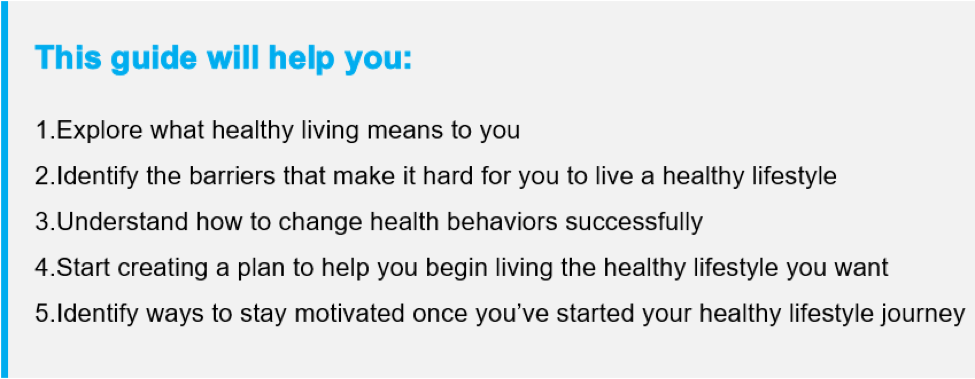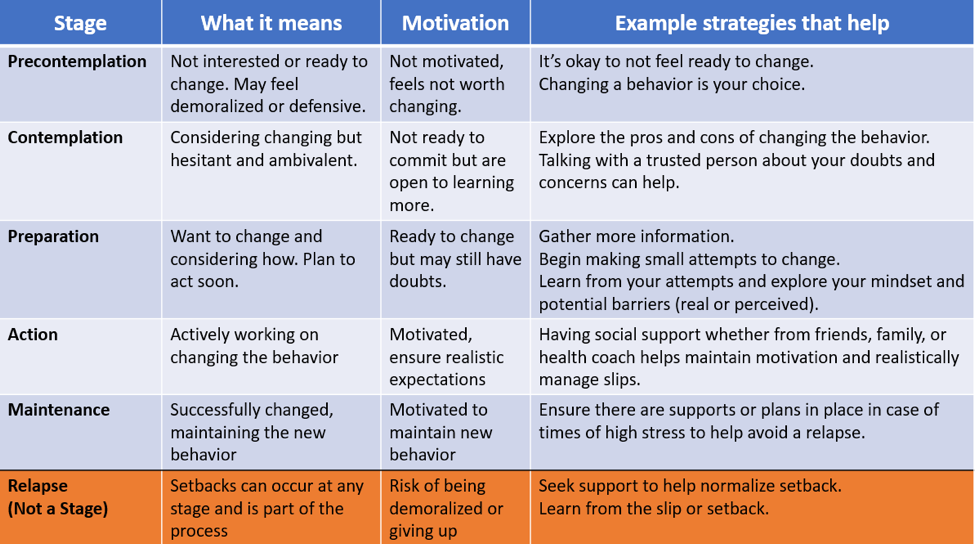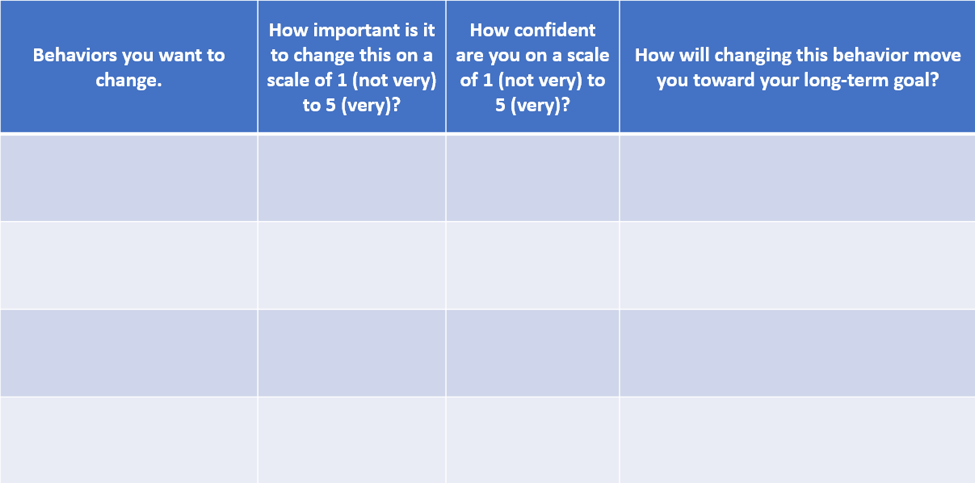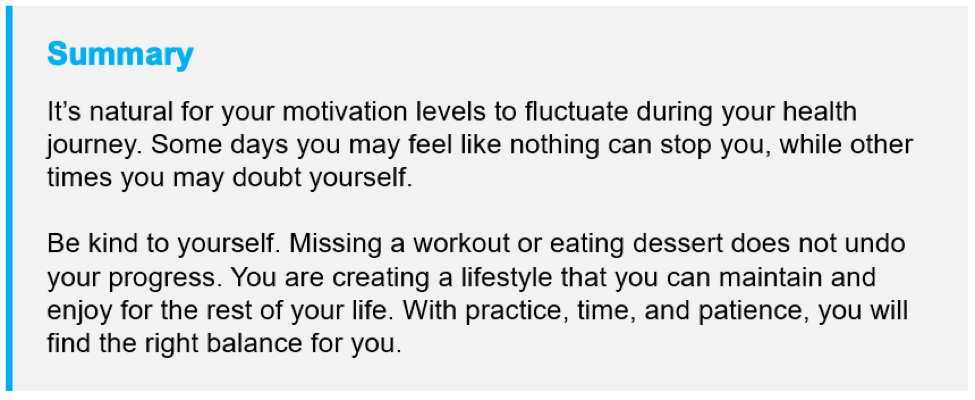The Blog
Simple Strategies to Unlock a Healthy Lifestyle
 You likely already know what contributes to a healthy lifestyle: eat a variety of nutritious foods, exercise regularly, maintain a healthy weight, stop smoking, and minimize your use of alcohol. Yet you find yourself struggling to create or maintain the healthy life that you want.
You likely already know what contributes to a healthy lifestyle: eat a variety of nutritious foods, exercise regularly, maintain a healthy weight, stop smoking, and minimize your use of alcohol. Yet you find yourself struggling to create or maintain the healthy life that you want.
Getting started on creating a healthy lifestyle isn’t always simple. Plus, it can feel overwhelming, especially if you’re trying to change multiple behaviors at once.
It takes time, effort, and commitment. You have to learn how to change habits that you may have been doing for so long that you don’t even realize you’re doing it. You also may face daily temptations, such as people you know encouraging you to eat the dessert or have an extra drink just this one time. Over time, it can feel hopeless, and you find yourself giving up—again.
Yet, building and maintaining a healthy lifestyle is well worth the effort. You’ll have more energy, be more productive, experience a more positive mood, and set a strong example for those you love. Lasting lifestyle change is possible—like any goal you set for yourself, it takes patience, persistence, and support. And you are more capable of this than you might think.
Changing unhealthy behaviors can take effort and time. Yet living a healthy lifestyle can reduce your risk of chronic diseases and increase your lifespan.
Whether you’re ready to get started or aren’t sure that now is the right time for you, this guide offers information and strategies to support you along every stage of the change process.
 A Healthy Lifestyle Is More Than What You Eat
A Healthy Lifestyle Is More Than What You Eat
A healthy lifestyle consists of behaviors and habits that help you minimize your risk of developing a chronic disease so you can enjoy a long life. Yet a healthy lifestyle involves more than eating the right foods or exercising regularly.
Achieving the balance necessary to sustain a healthy lifestyle involves more than action and habits. It also includes your mindset, beliefs, mood, environment, and social support network.
Establishing a healthy lifestyle isn’t a short-term goal like running a 5K race. Instead, it involves creating healthy habits that eventually become so routine that you’ll do them automatically. A benefit of establishing a routine is that it doesn’t require conscious thought or effort – it’s just a part of what you do.
Healthy routines also:
- Reduce your stress levels, which can improve your mood, attitude, and mental health.
- Reduce the number of decisions you make every day.
- Improve your sleep quality, especially if you’ve established good sleep hygiene as part of your healthy living routine.
- Increase the regularity of your everyday life, which helps provide a sense of order and meaningfulness to your life
- Save you time, which you can use on other activities you enjoy, such as spending more time with family or pursuing a hobby.
 Why Is Healthy Behavior Change so Difficult?
Why Is Healthy Behavior Change so Difficult?
Think of the last time you tried to make a healthy change. Maybe you resolved to lose weight, eat less sugar, sleep more, or exercise regularly. While these goals appear straightforward, they each involve you:
- Making multiple different decisions throughout the day
- Noticing less desirable habits
- Stopping those habits
- Establishing new healthier habits
Habits are behaviors that you repeatedly do, often with little to no conscious awareness, typically in response to a cue. Habits can be helpful or harmful.
Our brains form habits because they can increase our efficiency and save mental energy that we can use on more demanding tasks. For instance, when you get ready in the morning, you likely do the same set of behaviors without thinking too much. You don’t have to think every morning about how to brush your teeth or take a shower. You just do them as a part of your morning routine.
Unfortunately, unlearning habits isn’t always easy because:
1. Stopping established habits is a process that takes time.
If you’re trying to break a long-standing habit, it will take time, consistency, and patience. People commonly want to stop unwanted habits quickly. The expectation and desire are to get it over fast, so you can start doing the new behavior.
Having to put in the consistent effort is hard. When faced with difficulties or demands on your time, people often give up on the new habit too soon.
2. How you respond to slips or setbacks can impact your success.
Setbacks or slips happen. They’re a common part of the behavior change process. You can even use these events as opportunities to explore what is and isn’t working in the habit you’re trying to establish.
For example, if you’re trying to drink your coffee without sugar, maybe you realize that you’re more likely to slip when the sugar is near the coffee pot. You can talk to others in your household and ask that they help you keep the sugar away from the coffee pot.
Unfortunately, many people tend to put themselves down or label themselves when a slip or mistake occurs, instead of using it as a learning opportunity. The resulting negative self-talk can decrease your motivation and confidence. It can contribute to feeling like the change is too hard or that you can’t do it. Continuing to work on the behavior change will be even harder when the next slip occurs.
3. Past experiences can affect your mindset and confidence.
It’s common for people to attempt to change the same behavior or habit multiple times before succeeding. Consider New Year’s resolutions. Many people will set the same goal several years in a row. A survey by YouGov in December 2019 found that 64 percent of those surveyed were making the same resolutions in 2020 that they made in 2019.
The good news is that research suggests that every attempt you make to change to a healthy behavior helps. That said, how you think about your past attempts matter. You’ll have a greater chance of success if you think about past attempts with a positive or open mindset. You can learn from what worked and didn’t work to help guide your new effort. If you focus on the negative or criticize yourself, it will be harder to change the behavior successfully.
 Create a Healthy Lifestyle That Lasts By Understanding Your Readiness and the Process to Change
Create a Healthy Lifestyle That Lasts By Understanding Your Readiness and the Process to Change
Changing our behaviors might not feel easy. However, meaningful behavior change is possible whether you want to eat better, start exercising, or stop smoking. One popular and extensively researched framework for understanding intentional behavior change is the Stages of Change or Transtheoretical Model developed by James Prochaska and Carlo DiClemente.
The Stages of Change model helps you understand your readiness to change different behaviors and provides insight into what strategies can help. This information can help you:
- Set appropriate goals that match your stage of change
- Determine which behavior you most want to focus on at this time
- Understand what can help you continue to change
- Understand your level of motivation along with barriers
- Understand the types of strategies to help you move successfully through the change process
- Manage slips and setbacks effectively
Are you ready to change? Understanding the Stages of Change

Based on work by Prochaska and DiClemente on the Transtheoretical Model, more information at https://habitslab.umbc.edu/the-model/.
A critical component of the Stages of Change model is that people don’t move through the stages linearly. You can skip a stage or move back and forth between stages. You can experience a relapse at any stage, including Maintenance, which may send you back to an earlier stage.
Understanding and acknowledging your Stage of Change and readiness can help you avoid unnecessary frustrations. You may feel ready to change one behavior but aren’t interested in changing another one.
 How to Start Creating the Healthy Lifestyle You Want (No Matter Your Stage of Change)
How to Start Creating the Healthy Lifestyle You Want (No Matter Your Stage of Change)
As you begin to work towards your healthy lifestyle, remember that everyone’s journey can be different. There isn’t a specific time frame or one perfect strategy or solution. Along the way, you will have triumphs and experience setbacks. Changing our habits and routines takes time and doesn’t happen in a set sequence.
The following will help provide a guide or framework that you can use anytime to help you on your health journey. These five steps will help you clarify your goals, support your motivation, identify and learn from any barriers, set realistic goals, and build support.
1. Identify What You Want to Change
Your long-term goal may be to live a healthy lifestyle, but that can involve different behaviors. To avoid feeling overwhelmed by changing multiple things at once, take time to identify the behavior you want to start working on the most.
Not sure which behavior you want to focus on first? Try making a list of the behaviors you want to change and evaluate each one to help you decide. Here is an example chart that may help you.
 Remember, there is no right answer. Pick the behavior that makes the most sense to you. Some people find that once they start experiencing success in one area, it becomes easier for them to make other healthy changes.
Remember, there is no right answer. Pick the behavior that makes the most sense to you. Some people find that once they start experiencing success in one area, it becomes easier for them to make other healthy changes.
2. Write Down Your Why
Now that you’ve identified what you specifically want to change, you’ll want to write down why it’s important to you. Knowing your why can help keep you motivated and focused on your goal.
This step can help you whether you’re in the Contemplation, Preparation, or Action Stage of Change. Write this information in a health journal or other document. You can then use the journal or document to record and track your thoughts and feelings throughout your health journey.
When considering your reason for making this change, ask yourself:
- Why is it important to change this behavior now (if you’re in Contemplation, think about why it might be important in the future)?
- How does this behavior concern you if you don’t change it?
- What are your reasons for changing it?
- How will your life or health be different if this changes?
- How will you feel about yourself—emotionally and physically—if you make this change?
- What will your everyday life look like when you’ve changed this behavior?
3. Brainstorm Past Successes and Barriers
Every health behavior change or attempt that you’ve made can help you. Take time to write down all your past behavior change successes as well as attempts that didn’t work as planned. You can keep track of this information in your health journal or document.
When thinking about past attempts, look for:
- What helped you succeed—did you have social support, did you work on a goal with someone else, did you keep track with a chart or an app?
- What are some barriers you’ve experienced when changing this or other similar behavior in the past?
- What was your mindset like when you successfully changed a behavior? What kind of self-talk did you have?
- What helped you get through setbacks in the past?
- What helps you increase your confidence and motivation?
Be as specific as you can, especially how it felt to achieve your goal and how it impacted your life. Identifying what has helped you in the past can increase your confidence, motivation, and success on future behavior change attempts. Your mindset and belief about your ability to change is a critical part of making a behavior change. Reminding yourself of your success can help you.
You can also use this time to learn from what has hindered you in the past, so you can be mindful of potential similar barriers and find ways to handle the issue differently.
4. Create a SMART Goal
Setting realistic and achievable goals helps you establish something to work towards, so you know what to do to succeed. Goals can also help you stay motivated, track your progress, identify what is and isn’t working, and boost your confidence. Setting goals are especially helpful in the Preparation and Action stages.
SMART goals are a system you can follow to ensure you’re setting the right goals for you. Let’s say you wanted to eat healthier by having more healthy home-cooked dinners instead of fast food, which is eaten five nights a week after work. Here is how you could use the SMART goal system to help.
S = Specific
Be specific about your goal and behavior. For our example, if you said you wanted to “eat healthier,” that wouldn’t be specific. A more specific goal would be, “I will eat healthy home-cooked dinners instead of fast food.”
M = Measurable
You need to add a way to measure your goal, so you can tell if you are making progress. This measurement could be a time frame, an amount, or a number of occurrences that you or anyone else can objectively judge whether it was done. For our example, the goal could now be, “I will eat a healthy home-cooked dinner three days every week instead of fast food.”
A = Achievable
You want to set a goal that you can do and have the resources and time you need. Otherwise, you’re setting yourself up for failure. In our example, we can add how we are going to achieve the goal. The goal could be, “I will eat a healthy home-cooked dinner three days every week instead of fast food by doubling one of the home-cooked meals for leftovers.”
R = Realistic and Relevant
Evaluate your goal to see if it’s realistic for you at this time. In our example, the person is adding one more home-cooked meal a night and has indicated they will do that by making sure they have leftovers. Since they already cook two times a week, this is realistic. However, if the goal had been to go from eating out five days a week to zero days a week, that goal would likely set the person up for failure.
You should also make sure the goal helps you toward your larger goal. In our example, starting to eat more dinners at home will help the person eat healthier.
T = Time-bound
Including time frames, such as start or end dates, will help you track your progress. Be realistic about how long it will take. When the end date arrives, you can evaluate whether you’re ready to modify the goal, keep with the same goal, or are ready for a new goal.
In our example, the person could add time elements by stating, “Starting this Sunday, I will eat a healthy home-cooked dinner three days every week (Saturday, Sunday, and Monday) instead of fast food for the next 4 weeks. I will do this by doubling one of my weekend home-cooked meals for leftovers on Monday.”
5. Share Your Goal and Plan With a Trusted Person
Once you have a plan, sharing it with someone supportive who you trust may help increase your accountability. Be thoughtful about who you share your goal with to ensure you find people who provide the kind of support you need.
When talking with someone, you might also want to let them know what kind of support they can provide that will be helpful to you. You may need a friend to talk to about your feelings, but you don’t necessarily want them to solve your problems.
If sharing your goals makes you uncomfortable or feels too vulnerable, don’t share it with people you see every day. It’s critical that you feel comfortable and safe.
If you want to keep your journey private or would like additional support, you could seek an alternative form of help. Many options are available, including:
- Working with a health coach, who can help you set realistic goals, work through barriers, and achieve sustainable progress
- Using health apps like Noom, which combine behavior tracking with education and social support
- Following an evidence-based health program like Weight Watchers or the Mediterranean Diet
- Joining a local club, like a cycling or running group, where you’ll be around people who enjoy similar activities and are pursuing a healthy lifestyle
- Maintaining a health journal to work through your thoughts, feelings, and process
Support can be helpful if it’s the right kind for you.
 Staying Motivated After Starting Your Health Behavior Change Journey
Staying Motivated After Starting Your Health Behavior Change Journey
Following the five steps above will provide you with tools to help you stay motivated to change your health behavior. You’ll understand why you want to change and have it written down where you can reference it as needed. You’ll have set a realistic goal and set up a support system.
However, there are additional ways to help keep yourself motivated throughout the change process.
-
- Make time to review your health journal or document so you can see the progress you’ve made. If appropriate, take before pictures, write down measurements, or document health numbers like your blood sugars to remind yourself later how far you’ve come.
- Share your successes with your support system and take time to acknowledge what you’ve accomplished. These actions help support your confidence and belief in yourself, which helps keep you motivated.
- Reach out to your support system if you’re having a hard time or had a setback.
- Ask your support system to send you encouragement periodically, whether a text, email, or phone call.
- Reward yourself occasionally. Rewards can be internal, such as taking a few extra moments to enjoy how you feel after meditating or exercising. They can also be external. Be sure that rewards work towards your long-term goal, such as new workout clothes or a new song. External rewards should be used sparingly, such as when you reach a large goal.
- Support your mindset and mental health. You could read motivating quotes, participate in meditation or growth mindset activities, journal, or talk to a trusted support about your feelings and thoughts.
- Find ways to make your health journey fun. You’re building new healthy ways of living, so it’s important to enjoy them. If part of your health journey involves exercise, try new activities, including joining a team sport or club. If you’re trying to eat healthier, take a class that teaches you how to prepare new healthy foods.
 Next Steps
Next Steps
Congratulations on exploring how to start living a healthier lifestyle. Whether you’re in the early stages of the change process or are well on your way, there are resources that can provide you with additional information, strategies, and support along your journey.
Living Healthier: A Free Health Coaching Program for Texans
Could you use a little extra support as you work towards your health-related goals? Living Healthier is a free telehealth coaching program for people 18 years and older who currently live in Texas.
Our goal is to be a support system for people working to achieve health-related goals. After an initial consultation to identify what you want to work on, your health coach will provide weekly phone calls tailored to what you want to accomplish, including support, motivation, resources, and more. If you currently live in Texas and want to learn more, text or call (844)-262-6224 or visit the Living Healthier website.
Other Resources You May Like
- American Heart Association has multiple articles on aspects of living a healthy lifestyle in addition to information devoted to heart health.
- National Kidney Foundation has various resources available about kidney health and kidney disease.
- CDC or Centers for Disease Control and Prevention has a variety of articles on different health and wellness topics for all age groups.
